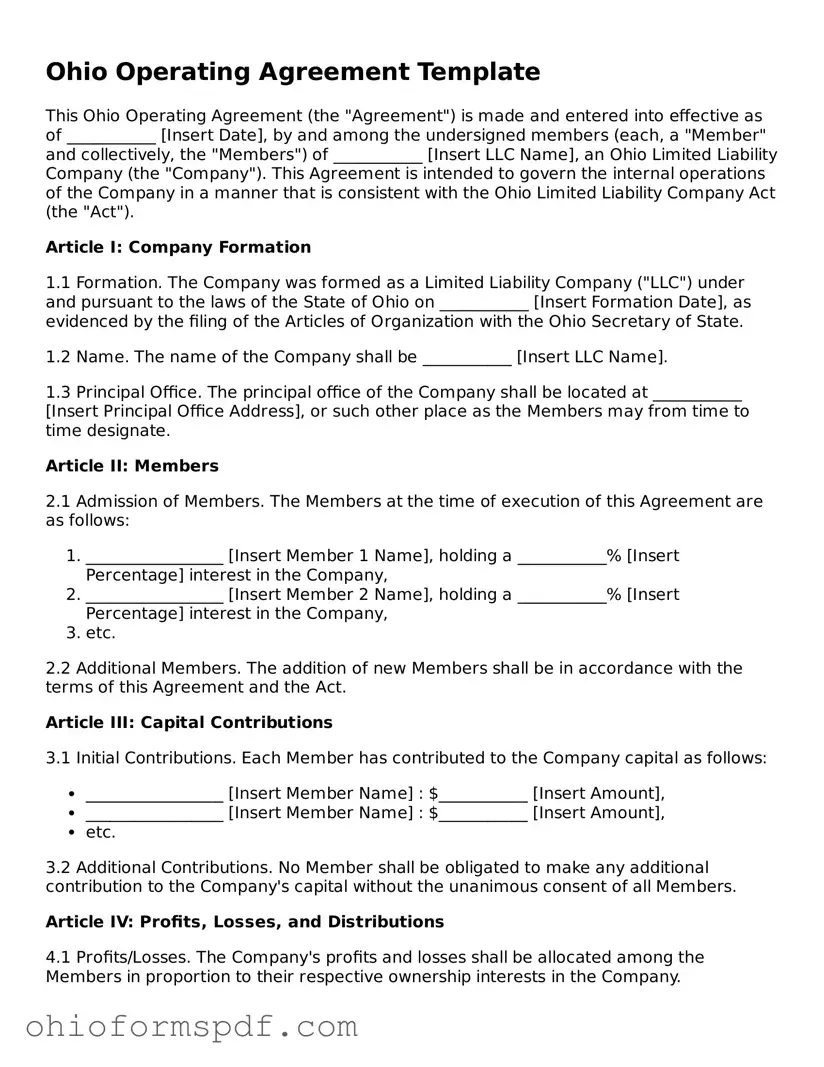Ohio Operating Agreement Template
This Ohio Operating Agreement (the "Agreement") is made and entered into effective as of ___________ [Insert Date], by and among the undersigned members (each, a "Member" and collectively, the "Members") of ___________ [Insert LLC Name], an Ohio Limited Liability Company (the "Company"). This Agreement is intended to govern the internal operations of the Company in a manner that is consistent with the Ohio Limited Liability Company Act (the "Act").
Article I: Company Formation
1.1 Formation. The Company was formed as a Limited Liability Company ("LLC") under and pursuant to the laws of the State of Ohio on ___________ [Insert Formation Date], as evidenced by the filing of the Articles of Organization with the Ohio Secretary of State.
1.2 Name. The name of the Company shall be ___________ [Insert LLC Name].
1.3 Principal Office. The principal office of the Company shall be located at ___________ [Insert Principal Office Address], or such other place as the Members may from time to time designate.
Article II: Members
2.1 Admission of Members. The Members at the time of execution of this Agreement are as follows:
- _________________ [Insert Member 1 Name], holding a ___________% [Insert Percentage] interest in the Company,
- _________________ [Insert Member 2 Name], holding a ___________% [Insert Percentage] interest in the Company,
- etc.
2.2 Additional Members. The addition of new Members shall be in accordance with the terms of this Agreement and the Act.
Article III: Capital Contributions
3.1 Initial Contributions. Each Member has contributed to the Company capital as follows:
- _________________ [Insert Member Name] : $___________ [Insert Amount],
- _________________ [Insert Member Name] : $___________ [Insert Amount],
- etc.
3.2 Additional Contributions. No Member shall be obligated to make any additional contribution to the Company's capital without the unanimous consent of all Members.
Article IV: Profits, Losses, and Distributions
4.1 Profits/Losses. The Company's profits and losses shall be allocated among the Members in proportion to their respective ownership interests in the Company.
4.2 Distributions. Distributions of cash or other assets of the Company shall be made to the Members in proportion to their respective ownership interests in the Company, subject to the Act and as decided by the Members.
Article V: Management
5.1 Management Structure. The Company shall be managed by its Members in accordance with the Act and the terms of this Agreement.
5.2 Decision Making. Decisions regarding the Company's major actions and operations shall require the unanimous consent of all Members, unless otherwise provided in this Agreement.
Article VI: Transfer of Membership Interest
6.1 Restrictions on Transfer. A Member may not transfer their interest in the Company without the prior written consent of all other Members, consistent with the Act.
Article VII: Dissolution
7.1 Events Causing Dissolution. The Company shall dissolve upon the occurrence of any of the following events:
- The unanimous consent of all Members,
- The sale, transfer, or other disposition of all, or substantially all, of the Company's assets,
- The Company no longer has any members, or
- Any other event as provided under the Act or agreed upon by the Members.
7.2 Winding Up. Upon the dissolution of the Company, the Company's affairs shall be wound up in accordance with the Act, all debts and liabilities of the Company shall be paid, and any remaining assets shall be distributed among the Members in proportion to their respective ownership interests.
This Agreement represents the entire understanding and agreement between the Members with respect to the subject matter hereof and supersedes all prior negotiations, agreements, and understandings among them. This Agreement may be amended only by a written agreement executed by all Members.
IN WITNESS WHEREOF, the undersigned have executed this Ohio Operating Agreement as of the date first above written.
_________________ [Insert Member Name] Signature: ___________________________________ Date: ___________
_________________ [Insert Member Name] Signature: ___________________________________ Date: ___________
etc.
